Dry vs. Wet Coffee Processing
You’ve seen the labels. You’ve asked your coffee-loving friends. Maybe you’ve even skimmed the argumentative forum posts. Still you’re left with that burning question: what’s the difference between “Dry” and “Wet” coffee preparation or processing method?
The quest for an answer was a long one, I’m sure, but you’ve finally found an oasis! First off, you’ll be happy to know that “Dry” and “Wet” aren’t just marketing buzzwords. They refer to how the beans were processed, and how that affects their taste. The Dry Method came first by a few centuries, so I’ll cover that one first.
THE DRY METHOD
(aka Unwashed or Natural Coffee)
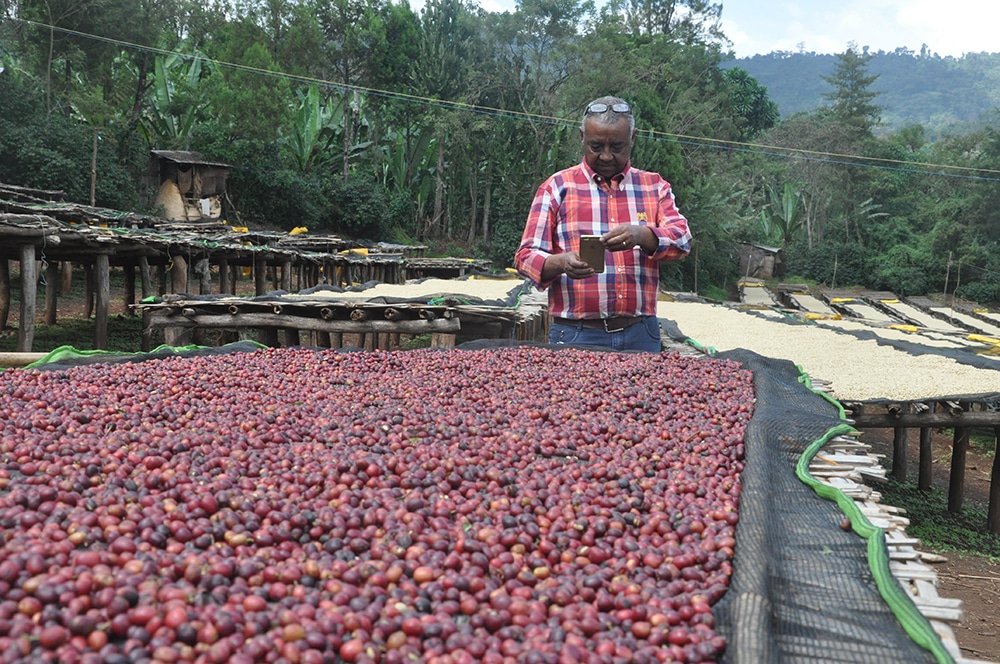
This one is the oldest by far and is actually still in practice, mostly in places with little rainfall and low humidity. Aside from the obvious sorting and cleaning, the whole process is as simple as leaving the cherries out to dry in the sun. Because… well, that’s exactly what they do—sometimes on flat patios, sometimes on raised nets or tables, but always until the red fruits turn brownish-black. The beans themselves are finally freed from their fleshy coverings, or “hulled,” at the mill before they’re bagged.
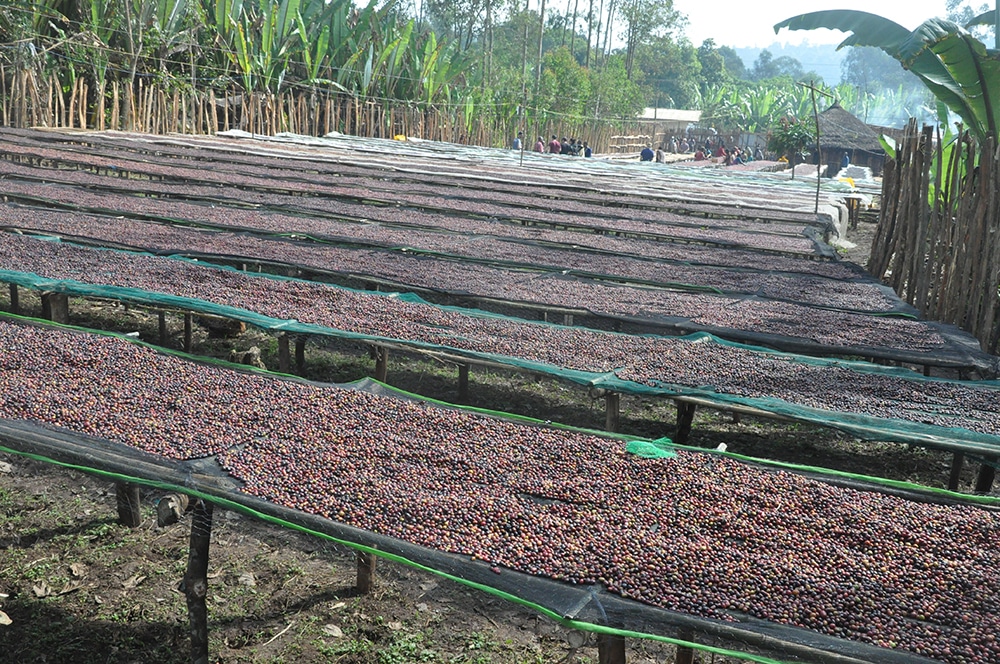
The drying part alone can take two to four weeks without machine assistance, and care must be taken not to over- or under-dry them, but the resulting beans’ taste is arguably worth it; leaving them inside their cherries for so long results in a deep, fruity flavor that’s hard to replicate.
THE WET METHOD
(aka Washed Coffee)

The Dry Method’s modern business rival relies on special machines and lots of—you’ll never guess—water! The coffee is sorted, cleaned, and processed almost entirely in the stuff! But what truly defines this method is that the beans get hulled near the start instead of at the end. Any bits of fruit left are taken care of by either fermentation (which calls for even more water) or a mechanical scrub-down (which doesn’t use water, but runs the risk of chipping the beans).
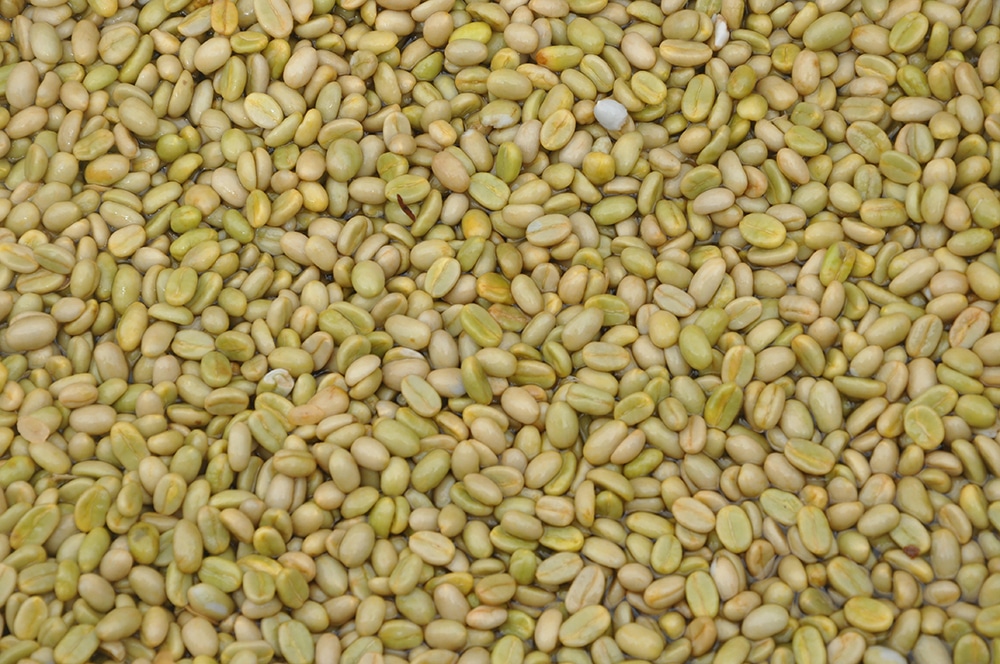
This method doesn’t take nearly as long as the Dry one, but its specific length can still vary wildly—the fermenting stage can take anywhere from 8 hours to a day and a half! Removing the fruit so early on lets the beans’ inherent flavor shine through: a bitter, yet crisp acidity that some might consider the “true” taste of coffee.
———
Well, there you have it—the Big Two processing methods! Them being polar opposites has caused more than a little debate among connoisseurs, but perhaps it’s a matter of preference instead of objective quality.
What’s that? You think both methods sound too extreme and wish there was some kind of middle ground? Well, you’re in luck!
THE SEMI-DRY METHOD
(aka Semi-Washed, Semi-Wet, Wet-Hulled, Pulped Natural, Semi-Natural, or Honey Processed Coffee)
Behold, the latest in coffee processing techniques! This method starts with the beans getting pulped out of their cherries, but—and this is key here—with the sweet inner layer left intact. After being left alone for a day, this layer is washed off and then it’s off to the drying beds. This sunbathing period is a little more strenuous than during the Dry Method; these still-sugary beans have to be watched closely and shuffled up to 3 times an hour, or mold will grow on them and ruin the whole batch.
But if all goes well, the beans’ aroma becomes the best of both worlds! Acidic like Wet coffee, fruity like Dry coffee, with a bonus aspect thrown in: a syrupy sweetness, almost like honey! The experimental nature of this method, combined with how hard it is to get right, makes “honey processed” coffee a rare sight in stores. If you manage to get your hands on some, you’re in for a truly special brew!
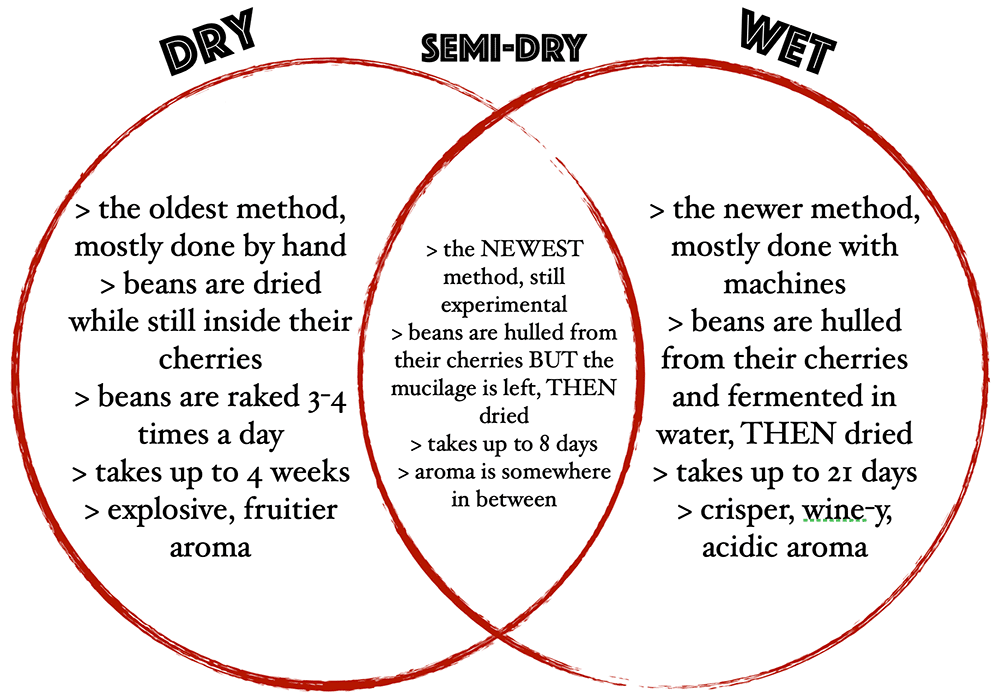


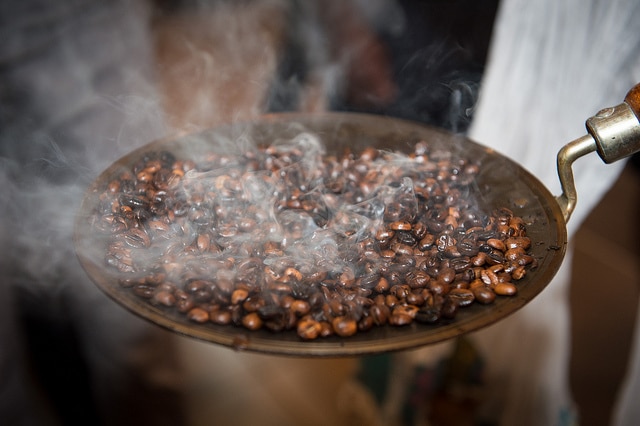
get good quality backlinks
mpmrhvlif kadnc cketqgo bvxu ndbuzhclcadvlks
… [Trackback]
[…] Read More here to that Topic: revocup.com/dry-vs-wet-processing/ […]
… [Trackback]
[…] Read More Information here to that Topic: revocup.com/dry-vs-wet-processing/ […]
… [Trackback]
[…] Find More on to that Topic: revocup.com/dry-vs-wet-processing/ […]
… [Trackback]
[…] There you can find 24099 additional Info on that Topic: revocup.com/dry-vs-wet-processing/ […]
… [Trackback]
[…] Here you can find 61477 more Information on that Topic: revocup.com/dry-vs-wet-processing/ […]
… [Trackback]
[…] Read More on that Topic: revocup.com/dry-vs-wet-processing/ […]
… [Trackback]
[…] Find More here on that Topic: revocup.com/dry-vs-wet-processing/ […]
… [Trackback]
[…] Info to that Topic: revocup.com/dry-vs-wet-processing/ […]
… [Trackback]
[…] Here you will find 43963 additional Info to that Topic: revocup.com/dry-vs-wet-processing/ […]
… [Trackback]
[…] Find More here to that Topic: revocup.com/dry-vs-wet-processing/ […]
… [Trackback]
[…] Find More on that Topic: revocup.com/dry-vs-wet-processing/ […]
… [Trackback]
[…] Read More Information here on that Topic: revocup.com/dry-vs-wet-processing/ […]
… [Trackback]
[…] Find More here to that Topic: revocup.com/dry-vs-wet-processing/ […]
… [Trackback]
[…] Information to that Topic: revocup.com/dry-vs-wet-processing/ […]
… [Trackback]
[…] Here you can find 74663 more Info on that Topic: revocup.com/dry-vs-wet-processing/ […]
… [Trackback]
[…] Information on that Topic: revocup.com/dry-vs-wet-processing/ […]
… [Trackback]
[…] Here you can find 73940 more Info to that Topic: revocup.com/dry-vs-wet-processing/ […]
… [Trackback]
[…] There you can find 19204 additional Information on that Topic: revocup.com/dry-vs-wet-processing/ […]
… [Trackback]
[…] Read More Information here to that Topic: revocup.com/dry-vs-wet-processing/ […]
… [Trackback]
[…] Information to that Topic: revocup.com/dry-vs-wet-processing/ […]
… [Trackback]
[…] Read More on that Topic: revocup.com/dry-vs-wet-processing/ […]
… [Trackback]
[…] Find More here on that Topic: revocup.com/dry-vs-wet-processing/ […]
… [Trackback]
[…] Information to that Topic: revocup.com/dry-vs-wet-processing/ […]
… [Trackback]
[…] Find More on that Topic: revocup.com/dry-vs-wet-processing/ […]
… [Trackback]
[…] Find More here on that Topic: revocup.com/dry-vs-wet-processing/ […]
… [Trackback]
[…] Read More on on that Topic: revocup.com/dry-vs-wet-processing/ […]
… [Trackback]
[…] There you can find 6472 additional Information on that Topic: revocup.com/dry-vs-wet-processing/ […]
… [Trackback]
[…] Read More Information here to that Topic: revocup.com/dry-vs-wet-processing/ […]
… [Trackback]
[…] Read More here on that Topic: revocup.com/dry-vs-wet-processing/ […]
… [Trackback]
[…] Read More on that Topic: revocup.com/dry-vs-wet-processing/ […]
… [Trackback]
[…] Read More to that Topic: revocup.com/dry-vs-wet-processing/ […]
… [Trackback]
[…] Find More Information here to that Topic: revocup.com/dry-vs-wet-processing/ […]
… [Trackback]
[…] Info to that Topic: revocup.com/dry-vs-wet-processing/ […]
… [Trackback]
[…] Here you can find 27985 additional Info to that Topic: revocup.com/dry-vs-wet-processing/ […]
… [Trackback]
[…] Find More Information here to that Topic: revocup.com/dry-vs-wet-processing/ […]
… [Trackback]
[…] Find More here on that Topic: revocup.com/dry-vs-wet-processing/ […]
… [Trackback]
[…] Info on that Topic: revocup.com/dry-vs-wet-processing/ […]
… [Trackback]
[…] Find More on to that Topic: revocup.com/dry-vs-wet-processing/ […]
… [Trackback]
[…] Find More Information here on that Topic: revocup.com/dry-vs-wet-processing/ […]
… [Trackback]
[…] There you can find 89078 more Information to that Topic: revocup.com/dry-vs-wet-processing/ […]
… [Trackback]
[…] Here you will find 22126 additional Information to that Topic: revocup.com/dry-vs-wet-processing/ […]
… [Trackback]
[…] Read More here to that Topic: revocup.com/dry-vs-wet-processing/ […]
… [Trackback]
[…] Read More Info here on that Topic: revocup.com/dry-vs-wet-processing/ […]
… [Trackback]
[…] Find More Information here to that Topic: revocup.com/dry-vs-wet-processing/ […]
… [Trackback]
[…] Read More Info here to that Topic: revocup.com/dry-vs-wet-processing/ […]